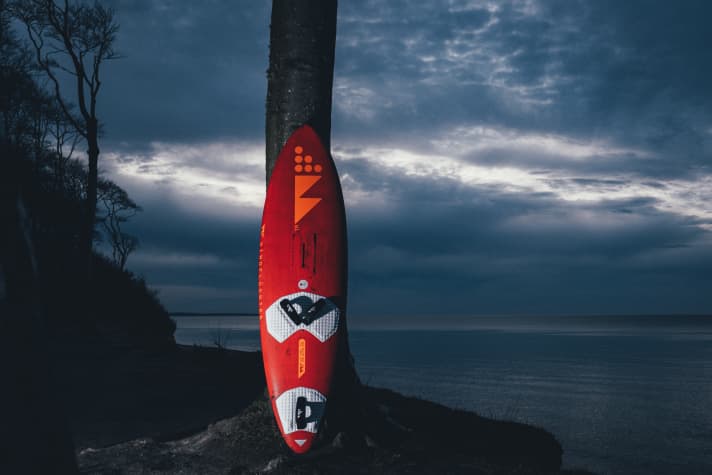





Lutz, you founded your Windflüchter brand 15 years ago. Looking back, what has changed and what is still the same?
The only thing that has remained the same is that I still do almost everything on my own (laughs). I have help for certain areas, e.g. designs, logos, website and testing, of course, but I do the lion's share on my own. However, there are also advantages to not bloating the whole thing too much. Apart from that, Windflüchter has of course also grown. In the beginning, I made things by hand in the basement, but since 2013 I've had a nice workshop with a CNC milling machine. The milling machine is the most important step in further developing boards, because you can change specific shape elements and realise ideas 1:1.
Does the milling machine open up unlimited possibilities?
I always try to work with small changes so that I can rule out the possibility of it being a complete miss, but still recognise a direction. A lot of work and material goes into every board and of course I don't want to produce something for the bin. In the end, every board that doesn't work is useless waste and a burden on the environment. Just as important as the CNC router, however, was that I found a supplier who could provide me with high-quality polystyrene cores. This is a very densely foamed material, similar to that used by Cobra in Thailand.(largest producer of windsurf boards, the ed.) is installed. The more densely the core is foamed, the more stable the basis for the entire structure of the board.
What is your speciality after 15 years?
My focus is still on wave and freewave boards, that is my core competence. I have certain shape ideas, but they can be individually adapted and customised to the maximum in terms of construction, size, strap position, fin setup and design. My boards are light, but not extremely light, because I want them to be durable. There is a lot of discussion about sustainability, bio-resins, boards made from flax and so on. But windsurf boards won't be able to be green in the foreseeable future. Different materials are glued together and as long as there is no one to separate and recycle the individual parts at the end, it is not sustainable. It's therefore best to build boards that last a long time, that's my goal. Ideally, none of the boards I sell are returned, because every return costs me time and therefore money. As long as nobody separates the individual parts at the end, a board can't really be sustainable. The best solution is therefore to use it for a long time.
As long as nobody separates the individual parts at the end, a board cannot be truly sustainable. The best solution is therefore to use it for a long time."
Are Customs on the upswing since coronavirus and the associated price rises and supply chain problems?
I have noticed that corona has prompted many people to look out more for regional suppliers. However, I've also noticed that this trend has died down again with the end of the pandemic. People are falling back into their old patterns and, of course, I can't keep up with the marketing power of the big brands.
Why is it so difficult for a brand like Windflüchter to grow?
If you wanted to grow, you would have to grow by a factor of ten to make it work. If you want to sell a certain number of units, you first have to expand your organisation and need people for marketing, sales and so on. Of course, that also involves a certain amount of risk and investment. And I also realised that I'm not the type for that. I like to be close to everything that happens at Windflüchter.

Would it be an option for you to build boards for other companies as well?
In terms of prototype development, that would be absolutely interesting. At the moment, some of the designers fly to Thailand, make changes to the shapes there and then the prototypes are transported halfway around the world by container and air freight, tested and then go into production. We are on site, the distances are short and this also gives us an advantage when things have to be done quickly. If you factor in transport costs and time, prototypes should not be much more expensive here than in Thailand. It already works very well with the Vayu brand wingboards: we develop here in northern Germany, build the prototypes, test them next door on the Baltic Sea and only when a board is to go into series production is it produced in Thailand. Of course, this would also be conceivable in the windsurfing sector.
You now live in Sweden, but shape in Rostock. How does that work together?
This separation is great because I'm regularly only in the workshop for a fortnight at a time, so I'm fully focussed on shaping. When I'm back in Sweden, I have my head free for other things, such as testing and development or new looks. The designs and logo have just had an update, modern and fresh. I'm broad and fully motivated for another 15 years of custom-made surfboards from northern Germany.
Thank you Lutz for the interview!
- More info at windfluechter-boards.com - here you can configure your favourite board in the Board Editor!
- OneYou can read a test of the Windflüchter T-Wave in surf 6/2023, in stores from 17 May!

